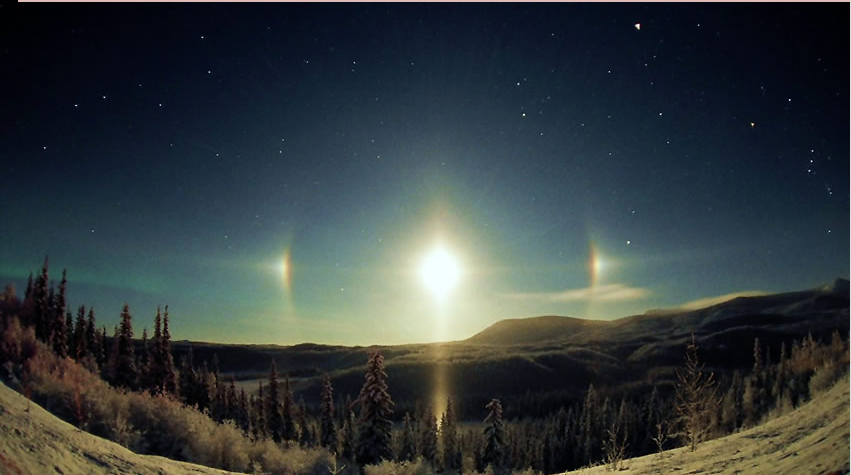Moon Dogs, Paraselenae, Parselenae
Moon Dogs, Paraselenae, Parselenae: A Spectacular Lunar Phenomenon
Have you ever looked up at the night sky and noticed something extraordinary surrounding the moon? Similar to the sun's halo, the moon also has its own celestial display known as paraselenae or parselenae. These captivating lunar halos, often appearing colorless or faintly colored, add a touch of enchantment to the night sky. In this article, we will explore the fascinating world of moon dogs and delve into the intricacies of paraselenae and parselenae.
Moon dogs, also referred to as paraselenae or parselenae, are the lunar equivalent of sundogs. These optical phenomena occur when light interacts with ice crystals in the atmosphere, creating a stunning display around the moon. While moon dogs are less commonly observed than their solar counterparts, they possess a unique charm that captivates those fortunate enough to witness them.
To catch a glimpse of these ethereal lunar halos, dark surroundings and a nearly full moon are ideal. The faintness of paraselenae and parselenae makes them more discernible against a darker backdrop. Although they may appear colorless to the naked eye, their subtle hues can be captured through long-exposure photography or by using specialized equipment.
The formation of moon dogs is closely tied to the presence of diamond dust in the air. Diamond dust consists of tiny ice crystals that float in the atmosphere, reflecting and refracting light to create dazzling optical effects. These crystals can form in extremely cold temperatures, often found in regions such as Snag, Yukon Territory, Canada, where temperatures can plummet to -40°F.
The intricate dance of light within paraselenae and parselenae often includes other atmospheric phenomena. Alongside the lunar halo, one may observe a partial lunar parhelic circle, a 22-degree halo, a lower pillar, or even a submoon. These additional elements add depth and complexity to the overall spectacle, making it a truly mesmerizing experience.
While the moon dogs themselves may not possess vibrant colors, they play an essential role in our understanding of atmospheric optics. Their faintness allows scientists to study the behavior of light as it interacts with ice crystals, providing valuable insights into the physics behind these celestial displays. By unraveling the mysteries of moon dogs, researchers can further comprehend the intricacies of atmospheric phenomena.
In conclusion, moon dogs, paraselenae, and parselenae create a captivating visual display in the night sky. These lunar halos, formed by the interaction of light with ice crystals, offer a glimpse into the enchanting world of atmospheric optics. Whether you observe them against a dark backdrop or capture their subtle hues through photography, moon dogs are a testament to the beauty and complexity of our natural world. So, next time you find yourself gazing at the moon, keep an eye out for these elusive celestial companions and let yourself be immersed in their ethereal allure.

Moondogs caught by David Cartier (images) near midnight on December 26, '07 above Snag, Yukon Territory, Canada. The display, which includes parts of of a paraselenic (lunar parhelic) circle, 22 degree halo, lower pillar and submoon was created by diamond dust in the -40F air. Snag lies in a hollow formed by the White River and tributaries, a good location for diamond dust formation. Praktica VLC3 35mm Camera, 16mm Zenitar lens, 15 second exposure on Fuji Natura 1600 film. Image ©David Cartier, shown with permission.
The moon forms halos just like the sun. Its equivalent of sundogs are called paraselenae or parselenae. Lunar halos are intrinsiclly faint and to see them dark surroundings and a near full moon are best. Visually they often appear colourless or almost so because their light is not strong enough to excite the colour sensors in our eyes.
Note: this article has been automatically converted from the old site and may not appear as intended. You can find the original article here.
Reference Atmospheric Optics
If you use any of the definitions, information, or data presented on Atmospheric Optics, please copy the link or reference below to properly credit us as the reference source. Thank you!
-
<a href="https://atoptics.co.uk/blog/moon-dogs-paraselenae-parselenae/">Moon Dogs, Paraselenae, Parselenae</a>
-
"Moon Dogs, Paraselenae, Parselenae". Atmospheric Optics. Accessed on April 27, 2024. https://atoptics.co.uk/blog/moon-dogs-paraselenae-parselenae/.
-
"Moon Dogs, Paraselenae, Parselenae". Atmospheric Optics, https://atoptics.co.uk/blog/moon-dogs-paraselenae-parselenae/. Accessed 27 April, 2024
-
Moon Dogs, Paraselenae, Parselenae. Atmospheric Optics. Retrieved from https://atoptics.co.uk/blog/moon-dogs-paraselenae-parselenae/.